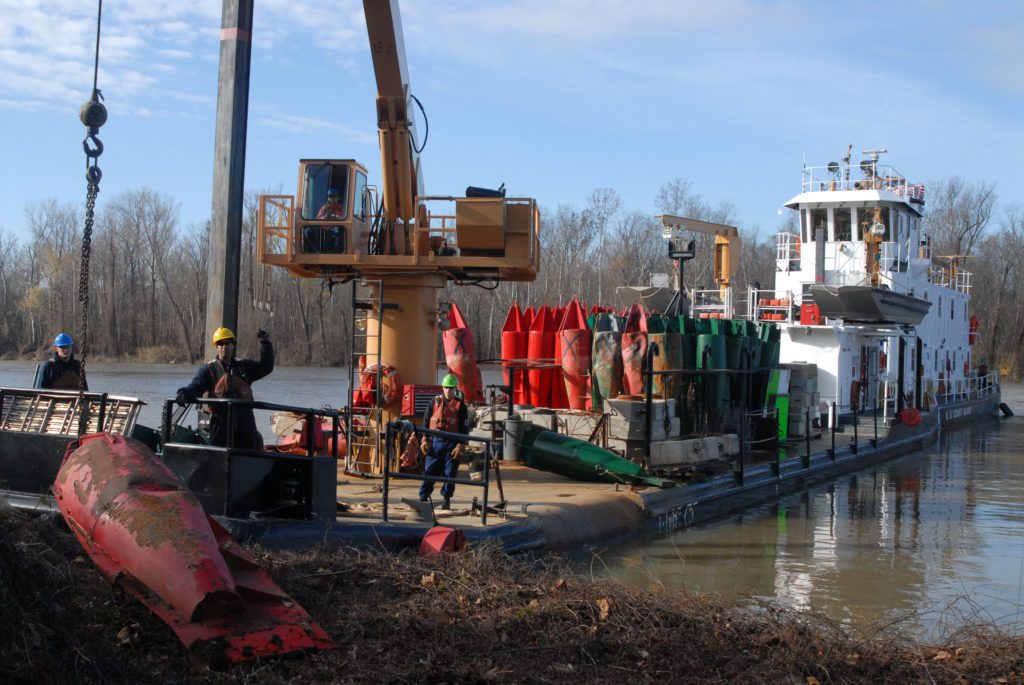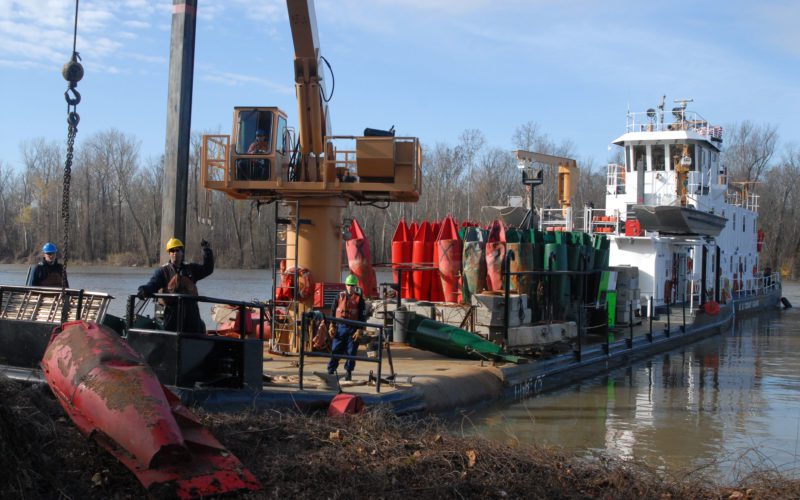
Imagine for a second driving your car through traffic in a strange city with missing or misleading road signs, traffic lights and lane markings. Over the last decade, that is exactly the kind of navigation western rivers mariners have increasingly been expected to perform.
Technology that would permit 100 percent virtual aids to navigation (ATONs) may become available someday, but we are not there yet. Although we currently have sophisticated navigation tools like depth sounders and electronic charts, river navigation is much more than playing a video game in a virtual reality. Mistakes in a virtual world do not cost millions of dollars and people’s lives.
The U.S. Coast Guard appears to have put buoy service very low on its priority list in recent years. This may be due to budget considerations and the perception that virtual ATONs can meet our needs more cheaply than real ones. I cannot speak for other segments of the maritime community, but what we desperately need on the western rivers are good old-fashioned buoys.
Let me see if I can illustrate what we’re up against. If you’ve never been on the flight deck of an aircraft carrier, it’s hard to imagine just how big they are. The U.S. Navy’s USS Gerald R. Ford is the largest aircraft carrier in the world. It covers almost 5 acres.
By contrast, my regular vessel and tow sometimes includes 56 barges covering 8.8 acres. Keep in mind that aircraft carriers normally operate in open water with a navigation crew of at least six people. River pilots typically navigate narrow river channels and heavy traffic by themselves.
It’s not just that we are operating in very close quarters. Due to the nature of alluvial rivers, the channel is always changing. The sand, gravel and silt of the river bottom is constantly moving in response to the current. And since the current speed changes with the river stage, there is no point at which the channel truly stabilizes for long. Experienced river mariners learn enough about hydrodynamics to be able to predict some of these changes, but some variables are truly unpredictable. Just ask the U.S. Army Corps of Engineers.
 The river stages can change by as much as two or three feet per day. Buoys that were set for a river stage of 12 feet in Memphis can be sticking up in dry sand a week later in a falling river. By the same token, in a rising river, those same buoys can be in 25 feet of water within the same short period. And with the faster current speed that accompanies rapid rises, much more room is needed to navigate safely because vessels slide harder around the bends.
The river stages can change by as much as two or three feet per day. Buoys that were set for a river stage of 12 feet in Memphis can be sticking up in dry sand a week later in a falling river. By the same token, in a rising river, those same buoys can be in 25 feet of water within the same short period. And with the faster current speed that accompanies rapid rises, much more room is needed to navigate safely because vessels slide harder around the bends.
Debris that floats downriver with a rapid rise in water levels can easily knock buoys out of position. The present Class 4 buoy design is only able to withstand an approximate 5 mph current. A rising river often exceeds that speed, so buoys will be diving and/or dragged off station. As a result, mariners cannot know exactly where they are.
Any river pilot can tell you a story about how they almost crashed chasing what turned out to be a floating buoy going downriver. Although we do our best to avoid hitting buoys, when pilots are confronted with a choice of whether to run over an off-station buoy or hit a vessel, bridge or rocky shoreline, guess which one loses? Diving buoys often wind up in our wheels, damaging them and causing expensive repairs and down time. Floating buoys also wind up in drift piles and Farmer John’s field, never to return because the Coast Guard does not have the time nor budget to salvage them. The riverbanks are littered with them.
I said all of that to say this: We still need buoys. But they need to be tended, not abandoned. Before going further, I want to make sure no one gets the impression I’m throwing the Coast Guard under the ferry boat. I have the utmost respect for the maritime men and women in blue. Unlike other branches of the military, their mission keeps them in a constant state of war, and I try not to miss any opportunity to express my gratitude for their service to every one of them I see. By far, most of my Coast Guard acquaintances have been very professional and dedicated to their service. They are just not properly equipped for the task we need. Their buoy tenders are ancient relics, and their command structure does not allow for the flexibility needed for the job anymore.
Buoy tenders on the Lower Mississippi River used to be on a two-week rotation, and they would go out every two weeks to reset and maintain the ATONs. A change in that schedule only occurred if river conditions changed so rapidly that they had to go back out sooner. Recently, there have been stretches of waterways that have not been fully marked in months. It’s no longer unusual to hear radio chatter about a vessel sighting a strange green or red floating object every hundred miles or so that could be what the old-timers called buoys. The state of buoys has become that much of a joke.
Most river pilots no longer even bother to report missing buoys to the Coast Guard because they know it will not make any difference. As I am writing this, approximately 75 percent of the buoys are missing or off-station on the Lower Mississippi, yet there are very few specific reports of them in the Broadcast Notice to Mariners because there are just too many. We share the most dangerous places with each other by radio and email and hope everybody gets the news.
There are several reasons for this current situation, one of which involves tender breakdowns. When a Coast Guard buoy tender vessel has a mechanical problem, it can require a lengthy and cumbersome bidding process for repairs. And since these vessels are ancient, there are many breakdowns. Adding to the problem, the Coast Guard’s command structure is too rigid to allow them to re-task their precious few resources where needed and when necessary to help alleviate these delays.
Although we are currently experiencing record low water conditions on the Lower Mississippi River and daily groundings, this is not just a temporary problem. This current crisis has only illuminated the problems we have been experiencing for several years now. I don’t want to minimize our industry’s accident costs due to missing buoys, but where it shows up most is in lost efficiency. Without proper buoys, tow sizes must be reduced accordingly; without buoys, we must always err on the side of caution. The trouble with deciding to always err on the side of caution is that it means we will always be in error.
Missing buoys translates into northbound traffic incurring much greater delays waiting for southbound traffic to clear. Soutbound vessels must use more flanking maneuvers because they do not have a visible buoy line to assist with risk assessment. These traffic delays also have a multiplying effect just like auto traffic jams where one delay creates another. One vessel grounding and breaking up tow can shut the river down for days. It’s not just the grounded vessel that loses time. Every tow around them does, too. We can’t take a detour for a few blocks around the wreck.
Our industry’s greatest efficiency is achieved by our ability to cheat physics. While we are going downstream, we are trying to stay in the middle of the channel as much as possible and thus take full advantage of the current speed. When we are going upstream, we are intentionally trying to run the edges of the channel, always seeking a happy medium between running in water that is deep enough for our draft but with reduced current and resistance. We call it “hunting the duck water.” However, skirting the slack water at the edge of the channel depends on the channel being properly marked with buoys. Without them, it is a guessing game that is not always compatible with marine safety.
All these things adversely impact the inland maritime industry and, by extension, our customers. These losses in productivity hurt no one as much as the American farmer. Their ability to ship grain at a low cost is vital to their remaining competitive in a world market. I strongly suspect that the true cost of having no buoys reaches into the billions of dollars. These losses are not virtual — they are real. Yes, buoys are expensive to build, deploy, repair and replace, but that is nowhere near as expensive as the cost of not having them.
I had the opportunity to speak with the former Coast Guard commandant briefly about these issues. He seemed concerned but didn’t offer much encouragement. He mentioned that the Coast Guard is in the process of designing and building new buoy tenders to meet this need, but that solution is still several years from reality. What are we supposed to do in the meantime? Before we build even more floating monuments to government inefficiency, I would like to suggest a slightly different approach and more immediate solution:
A Coast Guard/industry partnership: Private contractors utilizing existing commercial vessels and equipment can work the buoy lines and ATONs under direct Coast Guard supervision.
Benefits would include:
• More flexible scheduling, resource allocation and area of responsibility sharing;
• Reduced downtime for repairs without lengthy bidding processes;
• Avoiding the thorny issue of liability for privatizing the ATON system;
• Expanded mission to include salvage operations for lost buoys;
• Encourage development of new buoy designs for fast moving current and drift shedding.
There are already several examples of government and private sector partnerships, so why should the solution to this problem be any different? At the very least, it might serve as a temporary bridging program until new buoy tender vessels can be constructed. I suspect it could become a permanent solution that costs less and is more responsive to the industry’s needs.
Whatever the answer, at the very least it’s time for a meaningful discussion toward a more immediate solution.
No buoys is just no fun.•
Gregory Smith has been a licensed river pilot for 46 years and currently serves as captain of an 11,100-hp towboat operating on the Lower Mississippi River. He was co-recipient of the 2019 Seamen’s Church Institute Mariner of the Year award.

